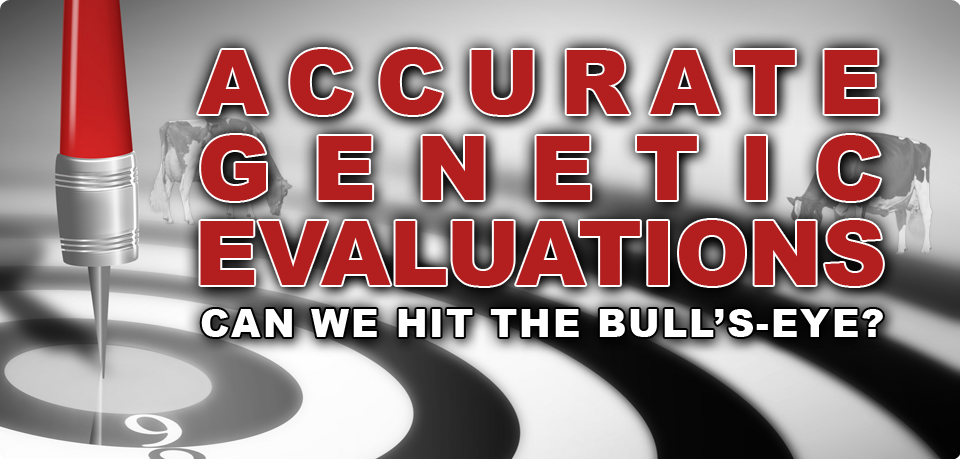Nobody wants to make decisions based on the wrong information. Good breeders know that accuracy is the key to making successful breeding decisions. Wouldn`t it be wonderful to have perfect data at our fingertips? There`s nothing wrong with dreaming the impossible dream but, realistically, in the business of cattle breeding, you can’t wait for that golden sunrise when perfection is a sure thing and 100% repeatable.
THE PAST: Almost-Perfect
Whenever we look back at animal-breeding history, a rosy glow settles over our perception of the past. For more than fifty years, we have constantly improved our North American genetic evaluation methods and models, proudly proclaiming them to be, if not perfect, at least the very best. Many of us felt we were destined to be at the top in cattle breeding forever. Then, the very success we reveled in spread our success and our genetics to everyone else. Accuracy was harder to ensure. Genetic evaluation methods and models are based on accurate recording of pedigree and performance data and all international input data is not created equal from country to country. Nevertheless we trusted the Animal Model (1989), the Test Day Model (Canada 1999) and Interbull (the international proof system). And it was still good.
AND THEN CAME GENOMICS: New Dart! New Target!
Hardly a decade into the 21st Century and Genomics comes along and changes our perception of the future. Here is a revolutionary new tool or dart, if you will, to take genetic aim with. Now there can be more focused selection much earlier in the bull or heifer’s life. Since that first official genomic evaluation in August 2009 accuracy has increased. Great! But now even the genetic target has changed. It is bigger. Now we don’t only target selection of proven bulls and performance recorded cows, but selection of young bulls and heifers, shortly after their birth. The full potential of what we can aim for has yet to be imagined.
TODAY CLOSE ONLY COUNTS in Horseshoes, Hand Grenades AND GENOMICS
In the interest of accurate information, it is important to look at everything that may be a negative influence on achieving this goal. In a May 2012 article entitled, “The Ongoing Challenge of Accurate Genomic Evaluations” Brian VanDoormal (CDN) points out those things that make precision targeting harder to achieve:
- Non-random usage
- MACE evaluations
- Parent Average less accurate when the parents are foreign
- Estimating unbiased proofs for foreign sires
- High priced foreign proven sire semen used on higher quality females in higher quality herds.
- Differential treatment adds to bias of non-random usage
- Non-random usage of elite progeny proven sires
- Non-random usage of high ranking genomic young bulls
VanDoormaal goes on to report that, “ CDN is actively researching methods to reduce or eliminate such biases and to better incorporate MACE evaluations of foreign sires and bull dams into Canadian genomic estimations and officially published proofs.” He emphasizes, “One immediate area of importance being researched is the development of methods to reduce bias in evaluations for foreign sires and bull dams.”
GENETIC EVALUATION ACCURACY: A Hard Target with Collateral Benefits
Each step that increases accuracy increases the trust that breeders can place in the information. In fine tuning genetic evaluations we benefit from increased accuracy in predicting other traits that previously we didn`t have data on: calf health; fertility; resistance to disease; specific components of milk; hoof health.
Not only has the arrival of genomics changed how genetic evaluations are calculated but it has also significantly changed male and female selection strategies by A.I. companies and breeders as well as semen usage trends by producers. Even breeders who do not use AI will benefit from genomics because they will have available to them bulls that test genomically high but that were not selected for AI. Previously there was a wider range of bulls sampled at great expense. With genomics, the entire gene pool of sires is being much more accurately identified for their genetic merit.
GENETIC EVALUATION ACCURACY is a MOVING TARGET
For more than 100 years cattle breeders have moved the industry ahead by selecting for the traits they felt were most important. There was a progressive emphasis as the focus changed or was expanded: amount of milk in a single day; total milk in a liftetime; butterfat; protein; and conformation. New models and young sire programs were developed. All of these had an impact but the potential for genomics impact is far greater. With genomics, large numbers of young bulls can be tested and eliminated with an enormous reduction in time and cost to the breeder and the industry. This adds to the burden of responsibility for genetic evaluations to be accurate and account for non-random selection and/or under-evaluated progeny proofs.
THE BULLVINE BOTTOM LINE
Will Genetic Evaluations ever achieve 100% accuracy? Only time will tell. The challenge we face now is to keep the system steadily improving for the impact having accurate information can have not only for cattle breeding today but for generations to come.
For more information check out our Genetic Evaluation Resource Center.

















Genomics is good… if it is accurate. Many top bull drop considerably.
I”ll ask again why did Semex come to the US to Genomic test it’s bulls if they have a good Genomic program in Canada?